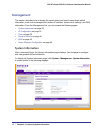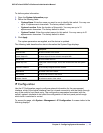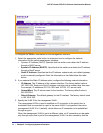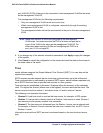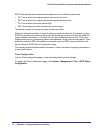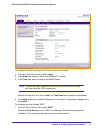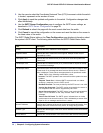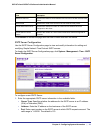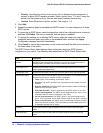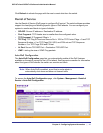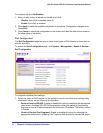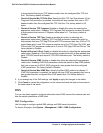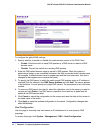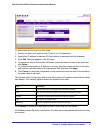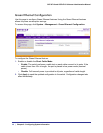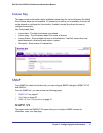
40 | Chapter 2: Configuring System Information
GS716Tv2 and GS724Tv3 Software Administration Manual
• Priority . Specifies the priority of this server entry in determining the sequence of
servers to which SNTP requests are sent. Enter a priority from 1–3, with 1 being the
default and the highest priority. Servers with lowest numbers have priority.
• Version. Enter the protocol version number. The range is 1–4.
2. Click Add.
3. Repeat the previous steps to add additional SNTP servers. You can configure up to three
SNTP servers.
4. To removing an SNTP server, select the check box next to the configured server to remove,
and then click Delete. The entry is removed, and the device is updated.
5. To change the settings for an existing SNTP server, select the check box next to the
configured server and enter new values in the available fields, and then click Apply.
Configuration changes take effect immediately.
6. Click Cancel to cancel the configuration on the screen and reset the data on the screen to
the latest value of the switch.
The SNTP Server Status table displays status information about the SNTP servers
configured on your switch. The following table describes the SNTP Global Status fields.
Field Description
Address Specifies all the existing Server Addresses. If no Server configuration exists, a
message saying “No SNTP server exists” flashes on the screen.
Last Update Time Specifies the local date and time (UTC) that the response from this server was
used to update the system clock.
Last Attempt Time Specifies the local date and time (UTC) that this SNTP server was last queried.
Last Attempt Status Specifies the status of the last SNTP request to this server. If no packet has been
received from this server, a status of Other is displayed:
• Other: None of the following enumeration values.
• Success: The SNTP operation was successful and the system time was
updated.
• Request Timed Out: A directed SNTP request timed out without receiving a
response from the SNTP server.
• Bad Date Encoded: The time provided by the SNTP server is not valid.
• Version Not Supported: The SNTP version supported by the server is not
compatible with the version supported by the client.
• Server Unsynchronized: The SNTP server is not synchronized with its
peers. This is indicated via the 'leap indicator' field on the SNTP message.
• Server Kiss Of Death: The SNTP server indicated that no further queries
were to be sent to this server. This is indicated by a stratum field equal to 0 in
a message received from a server.
Requests Specifies the number of SNTP requests made to this server since last agent
reboot.
Failed Requests Specifies the number of failed SNTP requests made to this server since last
reboot.



